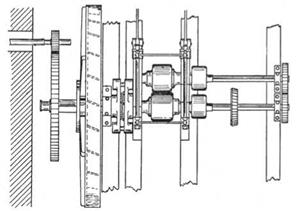In Cornwall in 1804, John Taylor at Wheal Travistock set up two discarded pump barrels in parallel (Barton 1961) as horizontal rolls to crush copper and tin ores for concentration by gravity. This experimental crusher, which became known as “Cornish rolls,” was driven by a steam engine (Figure 5.8). The rolls were only one of the many new methods that Taylor, a distinguished scientist who had been elected as a Fellow of the Royal Society, introduced. His advanced ideas of management and technical and financial control of metal mines transformed the industry (Lynch 2002).
The Cornish roll crusher was very successful and soon saw widespread use, making an important contribution to the size reduction of materials. But there was still much to be learned about crushing:
The whole secret of the efficient reduction of any material lies in a suitable crushing unit of the right capacity. This, I suppose, is obvious, but when one looks at some of the reduction plants in operation one is inclined to the belief that the obviousness of such a statement has escaped at least a few. The best way to reduce any material is also the cheapest: the energy must be proportioned to the work in hand, otherwise either the work is not being done properly or energy is being wasted. (Seymour 1924)
During the second half of the 19th century, inventors responded with jaw and gyratory crushers that are still used today, among them the Blake jaw crusher that was patented in 1858 and the Gates gyratory crusher that was patented in 1881.
By 1850, smooth double rolls for grinding ores driven by 15-kW motors were operating at 50 rpm and grinding 60 tpd of siliceous ores. These rolls had come a long way from the ones that Taylor used in Cornwall in 1805. From 1890 to 1910, the cyanide and flotation processes were established (see Chapter 7), and reliable fine crushers were
|
|
FIGURE 5.8 Cornish rolls (Lebeter 1949b)
required to grind ores at high rates to less than 5 mm, which was suitable then for ball mill feed. Roll crushers were the answer, and models were built that were stronger and more compact than those previously available and operated at higher speeds. By 1925, rolls were 1.8 m in diameter and 0.53 m wide and were powered by 112-kW motors. They typically ground siliceous ore to -3 mm.
Figure 5.9 shows the type of roll crusher that was in common use worldwide for most of the 20th century. Roll crushers used two steel rolls that rotated toward each other, exerting high pressure on the material passing between them. One roll revolved in fixed bearings, the other in a movable bearing-and-bracket assembly held in position by high-compression springs. The ore was fed into the wedge formed by the rotating rolls and was pulled into the breakage zone by gravity and friction between the ore and the face of the rolls until it passed through the shortest gap between the rolls. In the early part of the 20th century, the pressure on double-roll crushers was limited to 70 tons per roll by the materials of construction that could be used for the springs and by the design procedures available.
With the development of hydraulic pistons, much higher pressure became available, but the demand for double-roll crushers had decreased by then, because rod mills and very fine cone crushers had higher capacities and less downtime than the double-roll crushers.
To obtain a consistent product size, it was important to maintain an even wear across the face of the rolls. This required maintaining a uniform particle-size distribution and thickness of the stream of feed across the face of the rolls. Without these, wear patterns across the face would be uneven, leaving an uneven gap between the roll faces and resulting in an adverse coarsening of the crusher product. Also, tramp steel could gouge the face of the rolls, which would also affect the size of the product. Generally, the maintenance on roll crushers was high, both on the roll faces and on the side wear plates.
Rolls were successfully used for fine crushing in aggregate plants until the 1920s, when they began to be replaced with fine-crushing modified gyratory crushers and then by cone crushers.

